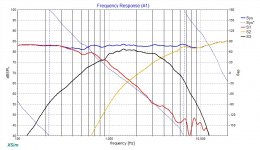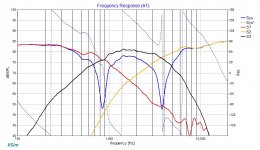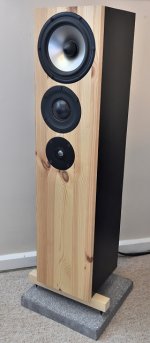In that case how do you get that phase linear? like instead of Z type Impedance curve how do you make it near flat without using DSP?I do pay attention to the reverse null and try to get them as deep as possible, however, I concentrate 99% of my efforts on getting phase response as smooth as possible. It's when the phase is smooth that the sound opens up allowing more insight into the studio/venue etc. Poor phase control can make the sound vague and lacking depth.
While it is normal to have phase follow for a driver pair around the crossover, it isn't essential that they be the same. Maybe a given situation calls for there to be a gap between them, in other words, their slopes can follow each other without the same absolute values. The reasons behind this choice are more involved than the current discussion, but when done this way the natural lobes will be tilted and the null will be less pronounced. The deep null case is just a middle ground option.
consider a 3 way crossover with 400Hz and 3800Hz frequencies. So which is more important to have good reverse null is it the upper frequency or lower?
I have already made PCB for the 2nd order LF and hence not possible with the reverse null with it so can we ignore the lower cutoff reverse null?
I have already made PCB for the 2nd order LF and hence not possible with the reverse null with it so can we ignore the lower cutoff reverse null?
Although the higher region is less tolerant, I would say neither. Reverse null is a sanity check, but if you are designing carefully by considering the phase response(s) throughout the crossover band, you shouldn't need to resort to this. Phase differences can be used to control the directivity index among other things so locking into a reverse null is denying that option.
Here's some response curves from my SEAS L18 / Morel EM1308 / SEAS 22TAF/G.
My first attempt at this speaker was to design a crossover with textbook roll off curves - LR4 for the bass/mid and LR2 for the mid/treble. It measured well but somehow the sound didn't gel. It was flat and colouration free, but that feeling of being in the room with the performers was missing.
My final design lead to the images below. I abandoned the textbook slopes in favour of producing a speaker that put me in touch with the music. I can now tell where the studio walls are! It has depth, ambience, separation, excitement and rythm - all the things the early version lacked.
My first attempt at this speaker was to design a crossover with textbook roll off curves - LR4 for the bass/mid and LR2 for the mid/treble. It measured well but somehow the sound didn't gel. It was flat and colouration free, but that feeling of being in the room with the performers was missing.
My final design lead to the images below. I abandoned the textbook slopes in favour of producing a speaker that put me in touch with the music. I can now tell where the studio walls are! It has depth, ambience, separation, excitement and rythm - all the things the early version lacked.
Attachments
Here's some response curves from my SEAS L18 / Morel EM1308 / SEAS 22TAF/G.
My first attempt at this speaker was to design a crossover with textbook roll off curves - LR4 for the bass/mid and LR2 for the mid/treble. It measured well but somehow the sound didn't gel. It was flat and colouration free, but that feeling of being in the room with the performers was missing.
My final design lead to the images below. I abandoned the textbook slopes in favour of producing a speaker that put me in touch with the music. I can now tell where the studio walls are! It has depth, ambience, separation, excitement and rythm - all the things the early version lacked.
Can you please post the response curves as
remove the System curve freq resp and phase
add the phase to s1 s2 and s3 and post it.. I want to see how the phases are gel in your speaker. Overall they look quite interesting.
schematic would also be great help.
Last edited:
The main advantage is that the levels across the crossover region will change smoothly as you move around the speaker, avoiding any weird lobing effects.
Also helps the two drivers add more smoothly together.
Deep null just tells you that drivers in phase at that observation point
However, this doesn't guarantee good off axis. Actually, it could be quite the opposite. It depends on the off axis behaviour of the 2 drivers.
- Status
- This old topic is closed. If you want to reopen this topic, contact a moderator using the "Report Post" button.
- Home
- Loudspeakers
- Multi-Way
- How to interpret reverse null?


